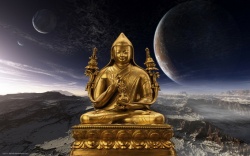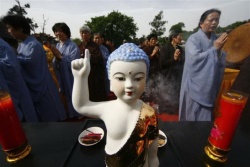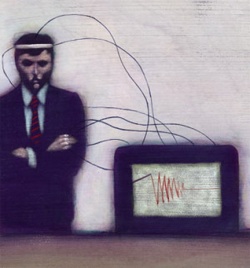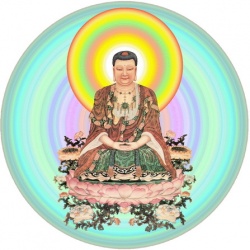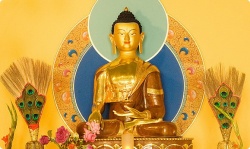Philosophy of Vasubandhu in Vimsatika and Trimsika
By Surendra Nath Das Gupta
The scheme of Vedanta philosophy is surprisingly similar to the idealism of Vasubandhu (280-360 A.D.) as taught in his Vimsatika with a short commentary of his own and Trimsika with a commentary of Sthiramati on it.(1) According to this Vijnanavada (idealism) of Vasubandhu all appearances are but transformations of the principle of consciousness by its inherent movement and none of our cognitions are produced by any external objects which to us seem to be existing outside of us and generating our ideas. Just as in dreams one experiences different objects in different places and countries without there being any objective existence of them or as in dreams many people may come together and perform various actions, so what seems to be a real world of facts and external objects may well be explained as mere creations of the principle of intelligence without any objective basis at all. All that we know as subjective or objective are mere ideation (vijnapti) and there is no substantive reality or entities corresponding to them, but that does not mean that pure non-conceptual (anabhilapyenatmana) thought which the saints realise is also false.(2) It is possible that the awareness of anything may become the object of a further awareness, and that of another, but in all such cases where the awareness is significant (arthavati) there are no entities or reality as represented by them; but this should not be interpreted as a denial of the principle of intelligence or pure know- _________________
1 Vijnaptimatratasiddhi containing two treatises of Vi and Trimsika. Paris 1925.
2 Yo balair dharmanam svabhavo grahyagrahakadih pari- kalpitas tena kalpitenatmana tesam nairatmyam na tvanabhilapyenatmana yo buddhanam visaya iti. Commentary on Vimsika, p. 6.
ledge as such. Vasubandhu then undertakes to show that the perceptual evidence of the existence of the objective world cannot be trusted. He says that taking visual perception as an example we may ask ourselves if the objects of the visual perception are one as a whole or many as atoms. They cannot be mere wholes, for wholes would imply parts; they cannot be of the nature of atoms for such atoms are not; separately perceived; they cannot be of the nature of the combination of atoms, for the existence of atoms cannot not be proved. (1) For if six atoms combine from six sides, that implies that the atoms have parts, for if six atoms combine with one another at one identical point, it would mean that the combined group would not have its size bigger than that of an atom and would therefore be invisible. Again if the objects of awareness and perception were only wholes, then suc- cession and sequence would be unexplainable and our perception of separate and distinct things would remain unaccountable. So, though they have no real objective existence, yet perception leads us to believe that they have. People are dreaming the world of objects in the sleep of the instinctive roots of the habit of false imaginative construction (vitathavik-alpabhyasavasananidraya) and in their dreams they construct the objective world and it is only when they would become awake with the transcendent indeterminate knowledge (lokott- aranirvikalpajnanalabhat prabuddho bhavati) that they would find the world-construction to be as false as the dream-construction of diverse appearances. In such a view there is no objective material world and our cognitions are not influenced by outside objects; how then are our minds influenced by good instructions and associations, and since none of us have any real physical bodies, how can one kill another? Vasubandhu explains this by the theory that the thought-currents of new person can sometimes determine the thought-yam na sidhyati Ibid., p. 7. ____________________
1 Napi te samhata visayibhavanti, yasmat paramanurekam dravyam na sidhyati. Ibid., p.7.
currents of another. Thus the idea of killing of a certain type may produce such a disturbance of the vital powers of another as to produce a cessation of the continuity of one's thought-processes which is called death.(1) So also the good ideas of one may influence the ideas of another for good.
In the Trimsika of Vasubandhu and its commentary by Sthiramati, this idealism is more clearly explained. It is said that both the soul (or the knower) and all that it knows as subjective ideas or as external objects existing outside of us are but transformations of pure intelligence (vijnanaparinama). The transformation (parinama of pure intelligenoe means the production of an effect different from that of the causal moment simultaneously at the time of the cessation of the causal moment.(2) There is neither externality nor subjectivity in pure intelligence, but still these are imposed on it (vijnana- svarupe parikalpita eva atama dharmasca). All erroneous impositions imply that there must be some entity which is mistaken as something else. There cannot be erroneous impositions on mere vacuity; so these erroneous impositions of various kinds of external characteristics, self etc. have to be admitted to have been made on the transformations of pure intelligence.(3) Both Vasubandhu and Sthiramati repudiate the suggestion of those extreme idealists who deny also the reality(4) of pure intelligence on grounds of interde- __________________________
1 Paravijnaptivisesadhipatyat paresam jivitendriyavi- rodhim kacit vikriya utpadyate yaya sabhagasantati- vicchedakhyam maranam bhavati. Vimsatika, p.10.
2 Karanaksannirodhasamakalah karanaksanavilaksanakar- yasya atmalabhah parinamah. Sthiramati's Commentary on Trimsika, p.16.
3 Upacarasya ca niradharasyasambhavad avasyam vijnana parinamo vastuto'sty upagantavyo yatra atmadharmo- pacarah pravarttate. Na hi niraspada mrgatrsnikadayah. Ibid. Compare Sankara's Commentary on Gaudapada's Karika.
4 Thus Lankavatara, one of the most important works on Buddhistic idealism, denies the real transformation of the pure intelligence or alayavijnana. See; Lankavatara, p. 46.
pendence or-relativity (samvrti). Vasubandhu holds that pure consciousness (vijnaptimatrata) is the ultimate reality. This ultimate consciousness is a permanent entity which by its inherent power (sakti) undergoes threefold transformation as the inherent indeterminate inner changes (vipaka) which again produce the two other kinds of transformation as the inner psychoses of mental operations (manana) and as the perception of the so-called external sensibles (visayavijnapti).
The apprehension of all appearances or characterised entities (dharma) as the cognised objects and that of selves and cognisers, the duality of perceivers and the perceived is due to the threefold transformation of vipaka, manana and visayavijnapti. The ultimate consciousness (vijnaptimatra) which suffers all these modifications is called alayavijnana in its modified transformations, because it is the repository of all experiences. The ultimate principle of consciousness is regarded as absolutely permanent in itself and is consequently also of the nature of pure happiness (sukha), for what is not eternal is painful and this being eternal is happy.(l) When a saint's mind become fixed (pratisthita) in this pure consciousness( vijnaptimatra), the tendency of dual thought of the subjective and the objective (grahyagrahakanusaya) ceases and there dawns the pure indeterminate (nirvikalpa) and transcendent (lokottara) consciousness. It is a state in which the ultimate pure consciousness runs back from its transformations and rests in itself. It is divested of all afflictions (klesa) or touch of vicious tendencies and is therefore called anasrava. It is unthinkable and undemonstrable because it is on one hand pure self-consciousness (pratyatmavedya) and omniscience (sarvajnata) as it is divested of all limitations (avarana) ___________________________
1 Druvo nityatvat aksayataya; sukho nityatvad eva ya- danityam tad duhkham ayam ca nitya iti asmat sukhah. Sthiramati's commentary on Trimsika, p. 44.
and on the other hand it is unique in itself.(1) This pure consciousness is called the container of the seed of all (sarvabija) and when its first indeterminate and indefinable transformations rouse the psychosis-transformations and also the transformations as sense-perceptions, these mutually act and react against one another and thus the different series rise again and again and mutually determine one another. These transformations are like waves and ripples on the ocean where each is as much as the product of others as well as the generator of others.(2)
In this view thought (vijnana) is regarded as a real subtance and its transformations are also regarded as real and it is these transformations that are manifested as the selves and the charactrised appearances.(3) The first type of transformations called vipaka is in a way the ground of the other two transformations which contain the indeterminate materials out of which the manifestations of the other two transformations appear. But as has already been pointed out, these three different types of transformations again mutually determine one another. The vipaka transformations constain within them the seeds of the constructive instincts (vikalpavasana) of the selves as cognisers, the constructive instincts of colours, sounds etc., the substantive basis (asraya) of the attribution of this twofold constructive instinct as well as the sense-faculties and the localisation of space- determinations (sthanavijnapti or bhajanalokasannivesa-vij- ________________________
1 Alayavijnana in this ultimate state of pure consciousness (vijna-primatrata is called the cause (dhatu) of all virtues, and being the [[Wikipedia:Absolute (philosophy)|ultimate)] state in which all the dharmas, or characterised appearances, had lost all their limitations it is called the dharmakaya of the Buddha (mahamnueh bhumiparamitadibhavanaya klesajneyavarana- prahanat... sarvadharmavibhutualabhata's ca dharmakaya ity ucyate).
2 Tac ca varttate srotasanghavat. Ibid., p. 21.
3 Avasyam vijnanaparinamo vastuto'sty upagantavyo yatratmadharinopacarah pravarttate. Ibid., p.16.
napti). They are also associated in another mode with sense-modifications involving the triune of the sense (indriya), sense-object (visaya) and cognition (and each of these triune is again associated with a characteristic affective tone corresponding with the affective tones of the other two members of the triune in a one to one relation), attention (manaskara), discrimination (samjna), volition (cetana) and feeling (vedana).(1) The vipaka transformations have no determinate or limited forms (aparicchinnalambanakara) and there are here no actualised emotional states of attachment, antipathy or the like which are associated with the actual pleasurable or painful feelings. The vipaka transformations thus give us the basic concept of mind and its principal functions with all the potentialities of determinate snbject-object consciousness and its processes. There are here the constructive tendencies of selves as perceivers, the objective constructive tendencies of colours, sounds etc., the sense-faculties etc. attention, feeling, discrimination, volition and sense-functioning. But none of these have any determinate and actualised forms. The second grade of transformations called ___________________________
1 Feeling (vedana) is distinguished here as painful, pleasurable, and as the basic entity which is neither painful nor pleasurable, which is feeling per se (vedana anubhavasvabhava, sa punar visayasya ahlada- kaparitapakatadubhayakaraviviktasvarupasaks kaparita This feeling per se must be distinguished again from the non-pleasurable- painful feeling existing along with the two other varieties, the painful and the pleasurable. Here the vipaka transformations are regaded as evolving the basic entity of feeling and it is therefore undifferentiated in it as pleasure or pain and is hence called "feeling as indifference (upeksa)" and undifferentiated (avyakrta). The differentiation of feeling as pleasurable or as painful takes place only as a further determination of the basic entity of feeling evolved in the vipaka transformations of good and bad deeds (subhasubhakarmavipaka). Good and bad (subhasubha) are to be distinguished from moral and immoral as potential and actual determinations of virtuous and vicious actions.
manana represents the actual evolution of moral and immoral emotions and it is here that the mind is set in motion by the ignorant references to the mental elements as the self, and from this ignorance about the self is engendered self-love (atma-sneha) and egoism (atma-mana). These references are again associated with the fivefold universal categories of sense functioning, feeling, attention, volition and discrimination. Then comes the third grade of transformations which are associated with the fivefold universal categories together with the special manifestations of concerte sense-perceptions and the various kinds of intellectual states and moral and immoral mental states such as desire (chanda) for different kinds of sense-experiences, decisions (adhimoksa) in conclusions firmly established by perceptions, reasoning etc., memory, attentive reflection (samadhi), wisdom (prajna), faith and firm will for the good (sraddha), shamefulness (hri) for the bad etc. The term alayavijnana is given to all these three types of transformations, but there is underneath it as the permanent passive ground the eternal and unchangeable pure thought (vijnaptimatrata).
It may be pointed out here that in this system of philosophy the eternal and unchangeable thought substance undergoes by virtue of its inner dynamics three different orders of superficial changes which are compared with constantly changing streams and waves. The first of these represents the basic changes which later determine all subjective and objective possibilities; the second starts the process of the psychosis by the original ignorance and false attribution of self-hood to non-self elements, self-love and egoism, and in the third grade we have all the concrete mental and extra-mental facts. The fundamental categories make the possibility of mind, mental processes and the extra-mental relations evolve in the first stage of the transformation and these abide through the other two stages of the transformation and become more and more complex and concrete in course of their association with the categories of the other transformations. In analysing the knowledge situation, Vasubandhu does not hold that our awareness of blue is only a modification of the "awareness" but he thinks that an awareness has always two relations, a relation with the subject or the knower (grahakagraha) and a relation with the object which is known (grahyagraha). Blue as an object is essential for making an awareness of blue possible, for the awareness is not blue, but we have an awareness of the blue. But Vasubandhu argues that this psychological necessity is due to a projection of objectivity as a necessary function of determinate thought and it does not at all follow that this implies that there are real external objects existing outside of it and generating the awareness as external agent. Psychological objectivity does not imply ontological objectivity. It is argued that if the agency of objective entities in the production of sense-knowledge be admitted, there could not be any case where sense-knowledge can be admitted to be produced without the operation of the objective entities, but since in dreams and illusions such sense-knowledge is universally regarded as being produced without the causal operation of such objective entities, no causal operation can be admitted to the objective entities for the production of sense-knowledge.
